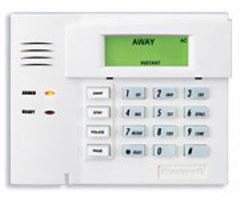Honeywell 6150RF (K4392V2-H M7240) Owners Manual
Related Products

Related Categories
Document Transcript
K4461-1V1 8/05 Rev. B
ADEMCO 6150RF
ADEMCO 6150RF
ADEMCO 6150RF
ADEMCO 6150RF
Keypad/Transceiver
Keypad/Transceiver
Keypad/Transceiver
Keypad/Transceiver
USER GUIDE
Keypad Features
DISPLAY
The keypad features a three-digit numeric display for zone identification and pre-designated English-
language prompts (e.g., “ALARM,” “AWAY,” “STAY,” “CHECK,” etc.) for indicating system status. (Refer to
Figure 1.)
FUNCTION KEYS
The function keys are located behind a decorative door and are continuously backlit for ease in use.
(Refer to
the User’s Guide provided with the control panel for detailed instructions on the use of these keys.)
The function keys include keys for panic alarm activation. The panic alarms are activated by pressing key
pairs [1] & [*], [3] & [#], or [*] & [#], or a Special Function Key (see below). Whether these panic keys
function and the type of panic alarms they produce is determined by the control panel’s capability and
programming.
(Check with your installer for the further information regarding these keys.)
SOUNDER
The sounder is a piezo-electric sounder that pulses for fire alarms and generates a two-tone sound for
burglary and audible panic alarms.
KEYPAD LEDS
The keypad contains two LEDs that indicate the status of the system as follows:
LED Function
Green (Ready)
Lights when the system is ready to arm (no zone faults are
present).
Red (Armed)
Lights when the system is armed.
SPECIAL FUNCTION KEYS
These are four keys located to the left of the numeric keys (refer to Figure 1). The keys may be programmed
by your installer for panic alarms or other special functions such as macros (a frequently used series of key
entries).
Function keys must be held down for at least 2 seconds to activate an alarm.
(Check with
your installer for the programmed function of these keys.)
1
OFF
4
MAX
7
INSTANT
READY
2
AWAY
5
TEST
8
CODE
0
3
STAY
6
BYPASS
9
CHIME
#
ARMED
READY
6150RF-00-001-V1
Figure 1 - ADEMCO 6150RF Keypad/Transceiver (Front Door Removed)
User Mode
This mode gives you the capability of enabling and disabling individual wireless keys that have been
directly programmed into the ADEMCO 6150RF. This is particularly useful if a user loses a wireless key.
This mode may only be accessed if the ADEMCO 6150RF is powered up for at least 1 minute.
Only
wireless
keys programmed directly into the ADEMCO 6150RF may be enabled and disabled using this mode.
ENTER THE USER MODE
Press the [1] and [3] keys simultaneously for a few seconds (make sure the unit has been powered for at
least 1 minute prior).
CHANGING THE STATUS OF A TRANSMITTER
On the display, “dE” and “-” flashes alternately. Enter the number of the wireless key transmitter (1-8).
Then “d” and the wireless key number you entered flash alternately with “1” or “0” on the display. A “1”
indicates the wireless key is enabled, a “0” indicates it is disabled. Enter [1] to enable or [0] to disable the
wireless key. All wireless keys are defaulted to 1 (enabled).
Press the
[
✻
]
to accept the entry.
Repeat the procedure for all the wireless keys whose status you want to change.
EXITING THE USER MODE
To exit the User mode press
[
✻
]
when “dE” and “–” flash alternately on the display.
FEDERAL COMMUNICATIONS COMMISSION STATEMENTS
The user shall not make any changes or modifications to the equipment unless authorized by the Installation Instructions or Use
r's Manual.
Unauthorized changes or modifications could void the user's authority to operate the equipment.
FCC CLASS B STATEMENT
This equipment has been tested to FCC requirements and has been found acceptable for use. The FCC requires the following statem
ent for
your information:
This equipment generates and uses radio frequency energy and if not installed and used properly, that is, in strict accordance
with the
manufacturer's instructions, may cause interference to radio and television reception. It has been type tested and found to com
ply with the
limits for a Class B computing device in accordance with the specifications in Part 15 of FCC Rules, which are designed to prov
ide
reasonable protection against such interference in a residential installation. However, there is no guarantee that interference
will not occur in
a particular installation. If this equipment does cause interference to radio or television reception, which can be determined
by turning the
equipment off and on, the user is encouraged to try to correct the interference by one or more of the following measures:
• If using an indoor antenna, have a quality outdoor antenna installed.
• Reorient the receiving antenna until interference is reduced or eliminated.
• Move the radio or television receiver away from the receiver/control.
• Move the antenna leads away from any wire runs to the receiver/control.
• Plug the receiver/control into a different outlet so that it and the radio or television receiver are on different branch ci
rcuits.
• Consult the dealer or an experienced radio/TV technician for help.
INDUSTRY CANADA CLASS B STATEMENT
This Class B digital apparatus complies with Canadian ICES-003.
Cet appareil numérique de la classe B est conforme à la norme NMB-003 du Canada.
FCC / IC STATEMENT
This device complies with Part 15 of the FCC Rules, and RSS 210 of IC. Operation is subject to the following two conditions: (1
) This device
may not cause harmful interference (2) This device must accept any interference received, including interference that may cause
undesired
operation.
Cet appareil est conforme à la partie 15 des règles de la FCC & de RSS 210 des Industries Canada. Son fonctionnement est soumis
aux
conditions suivantes: (1) Cet appareil ne doit pas causer d' interferences nuisibles. (2) Cet appareil doit accepter toute inte
rference reçue y
compris les interferences causant une reception indésirable.
ÊK4461-1V1eŠ
K4461-1V1 8/05 Rev. B
2
2 Corporate Center Drive, Suite 100
P.O. Box 9040, Melville, NY 11747
Copyright © 2009 Honeywell International Inc.
www.honeywell.com/security
- Uploaded
